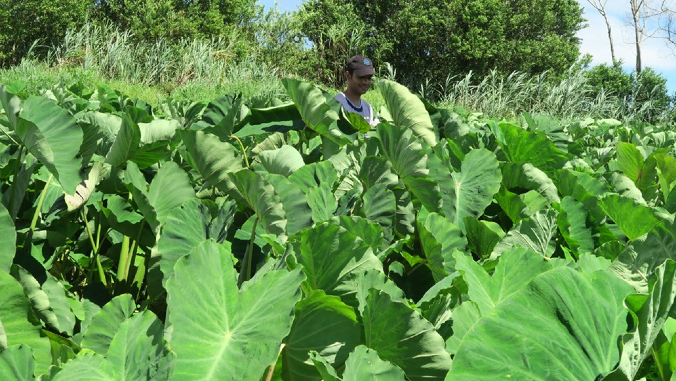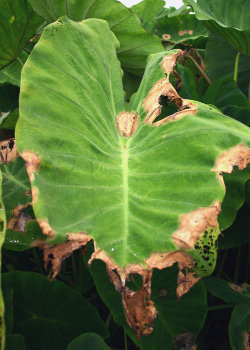
After a decades-long effort of cross breeding taro in the hopes of developing a species resistant to taro leaf blight (TLB), a highly infectious plant disease, a team of researchers has turned their sights on genomics. It’s a painstaking study of nucleotide sequences in the chromosomes of an organism. A research paper on the genomic work was published online in G3: Genes, Genomes, Genetics on August 1.

In the study, researchers from the University of Hawaiʻi, University of Tennessee and the U.S. Department of Agriculture generated a high-quality genome assembly for taro, a root crop that is widely cultivated in tropical regions and is important for food security.
The results are intended to inform studies of the origin, evolutionary history and breeding of the South Pacific crop. It is hoped the genome may also stimulate new genetic insights into this important tropical species.
“Overall, this project was a large team effort, involving three universities and U.S. Department of Agriculture researchers,” explained M. Renee Bellinger, a postdoctoral affiliate faculty and adjunct assistant professor of bioinformatics and genomics at UH Hilo who conducted genomic research on the project.
The long fight against taro leaf blight
All Hawaiian varieties of taro are vulnerable to TLB caused by the oomycete pathogen Phytophthora colocasiae.
UH researchers Professors Michael Shintaku and Susan Miyasaka have been trying to develop resistance to taro leaf blight for decades through breeding programs, but some trials resulted in varieties unacceptable for commercial poi processors. “TLB has been causing serious problems in Hawaiian kalo fields since the 1920s,” Shintaku said. “Samoa didn’t have TLB until about 1990, and then suffered dramatic losses.”

A Palauan taro resistant to TLB crossbred with Hawaiian taro produced some very good hybrid varieties that are currently used in commercial poi.
But while Shintaku and Miyasaka have worked toward a genomic project for decades, only recently have the cutting-edge genetic tools become accessible to conduct genomic research with this level of depth.
“This is the first genome assembly of taro that has been associated with genes that underpin resistance to taro leaf blight, information that may enhance taro breeding programs,” Bellinger said. “To me, this project exemplifies synergies that can be achieved by research teams working collaboratively towards a common goal.”

